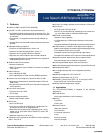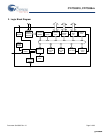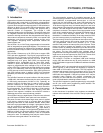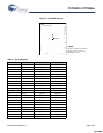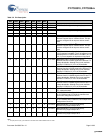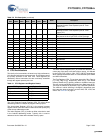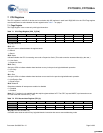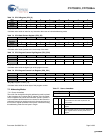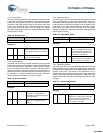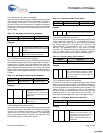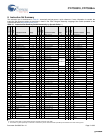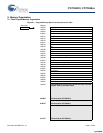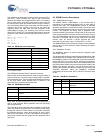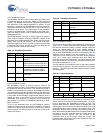
CY7C63310, CY7C638xx
Document 38-08035 Rev. *K Page 3 of 83
3. Introduction
Cypress has reinvented its leadership position in the low speed
USB market with a new family of innovative microcontrollers.
Introducing enCoRe II USB - “enhanced Component Reduction.”
Cypress has leveraged its design expertise in USB solutions to
advance its family of low speed USB microcontrollers, which
enable peripheral developers to design new products with a
minimum number of components. The enCoRe II USB
technology builds on the enCoRe family. The enCoRe family has
an integrated oscillator that eliminates the external crystal or
resonator, reducing overall cost. Also integrated into this chip are
other external components commonly found in low speed USB
applications, such as pull up resistors, wakeup circuitry, and a
3.3V regulator. Integrating these components reduces the
overall system cost.
The enCoRe II is an 8-bit Flash programmable microcontroller
with an integrated low speed USB interface. The instruction set
is optimized specifically for USB and PS/2 operations, although
the microcontrollers may be used for a variety of other embedded
applications.
The enCoRe II features up to 20 GPIO pins to support USB,
PS/2, and other applications. The IO pins are grouped into four
ports (Port 0 to 3). The pins on Port 0 and Port 1 may each be
configured individually while the pins on Ports 2 and 3 are
configured only as a group. Each GPIO port supports high
impedance inputs, configurable pull up, open drain output,
CMOS/TTL inputs, and CMOS output with up to five pins that
support a programmable drive strength of up to 50 mA sink
current. GPIO Port 1 features four pins that interface at a voltage
level of 3.3V. Additionally, each IO pin may be used to generate
a GPIO interrupt to the microcontroller. Each GPIO port has its
own GPIO interrupt vector; in addition, GPIO Port 0 has three
dedicated pins that have independent interrupt vectors (P0.2 -
P0.4).
The enCoRe II features an internal oscillator. With the presence
of USB traffic, the internal oscillator may be set to precisely tune
to USB timing requirements (24 MHz ±1.5%). Optionally, an
external 12 MHz or 24 MHz clock is used to provide a higher
precision reference for USB operation. The clock generator
provides the 12 MHz and 24 MHz clocks that remain internal to
the microcontroller. The enCoRe II also has a 12-bit program-
mable interval timer and a 16-bit Free Running Timer with
Capture Timer registers. In addition, the enCoRe II includes a
Watchdog timer and a vectored interrupt controller.
The enCoRe II has up to eight Kbytes of Flash for user code and
up to 256 bytes of RAM for stack space and user variables.
The power on reset circuit detects logic when power is applied
to the device, resets the logic to a known state, and begins
executing instructions at Flash address 0x0000. When power
falls below a programmable trip voltage, it generates a reset or
may be configured to generate an interrupt. There is a low
voltage detect circuit that detects when V
CC
drops below a
programmable trip voltage. It is configurable to generate an LVD
interrupt to inform the processor about the low voltage event.
POR and LVD share the same interrupt. There is no separate
interrupt for each. The Watchdog timer may be used to ensure
the firmware never gets stalled in an infinite loop.
The microcontroller supports 22 maskable interrupts in the
vectored interrupt controller. Interrupt sources include a USB bus
reset, LVR/POR, a programmable interval timer, a 1.024 ms
output from the free-running timer, three USB endpoints, two
capture timers, four GPIO Ports, three Port 0 pins, two SPI, a
16-bit free running timer wrap, an internal sleep timer, and a bus
active interrupt. The sleep timer causes periodic interrupts when
enabled. The USB endpoints interrupt after a USB transaction
complete is on the bus. The capture timers interrupt when a new
timer value is saved because of a selected GPIO edge event. A
total of seven GPIO interrupts support both TTL or CMOS
thresholds. For additional flexibility on the edge sensitive GPIO
pins, the interrupt polarity is programmed as rising or falling.
The free-running 16-bit timer provides two interrupt sources: the
1.024 ms outputs and the free running counter wrap interrupt.
The programmable interval timer provides up to 1 μsec
resolution and provides an interrupt every time it expires. These
timers are used to measure the duration of an event under
firmware control by reading the desired timer at the start and at
the end of an event, then calculating the difference between the
two values. The two 8-bit capture timer registers save a
programmable 8-bit range of the free-running timer when a GPIO
edge occurs on the two capture pins (P0.5, P0.6). The two 8-bit
captures may be ganged into a single 16-bit capture.
The enCoRe II includes an integrated USB serial interface
engine (SIE) that allows the chip to easily interface to a USB
host. The hardware supports one USB device address with three
endpoints.
The USB D+ and D– pins are optionally used as PS/2 SCLK and
SDATA signals so that products are designed to respond to
either USB or PS/2 modes of operation. The PS/2 operation is
supported with internal 5 KΩ pull up resistors on P1.0 (D+) and
P1.1 (D–), and an interrupt to signal the start of PS/2 activity. In
USB mode, the integrated 1.5 KΩ pull up resistor on D– may be
controlled under firmware. No external components are
necessary for dual USB and PS/2 systems, and no GPIO pins
need to be dedicated to switching between modes.
The enCoRe II supports in system programming by using the D+
and D– pins as the serial programming mode interface. The
programming protocol is not USB.
4. Conventions
In this data sheet, bit positions in the registers are shaded to
indicate which members of the enCoRe II family implement the
bits.
Available in all enCoRe II family members
CY7C638(1/2/3)3 only
[+] Feedback [+] Feedback



